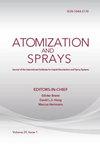A combined analytical/numerical approach to the modelling of the processes leading to puffing and micro-explosion in a composite multi-component fuel/water droplet
IF 0.9
4区 工程技术
Q4 ENGINEERING, CHEMICAL
引用次数: 0
Abstract
The previously developed analytical/numerical model for predicting heat transfer and component diffusion in composite multi-component droplets is adjusted for use in practical engineering applications related to the analysis of droplet heating and evaporation, and the onset of puffing and micro-explosions in those droplets. This adjustment allowed us to gain new insights into the previously developed models of these processes. The focus of the analysis is on kerosene/water droplets. It is demonstrated that the number of terms in the series in the analytical solution to the heat transfer equation can be reduced to just one or two to ensure that the maximal error of the model prediction does not exceed 1\%, unless we are interested in the processes at the very start of heating. At the same time, the minimal number of terms in the series in the analytical solution to the component diffusion equation should be at least seven to ensure that the errors of the prediction of the numerical code do not exceed 3\%. It is shown that, to ensure that the analytical/numerical code predicts physically consistent results, the maximal absolute error of calculation of the eigenvalues based on the bisection method cannot exceed 10^-7. It is shown that using these limiting values for each of these input parameters leads to about 50%-75% reduction in the CPU time required to obtain results close to those which were obtained using the non-optimised version of the numerical code. The overall reduction in CPU time can be as up to about 95%. The predictions of the adjusted analytical/numerical code are validated against in-house experimental data and data available in the literature.采用分析/数值相结合的方法,模拟多组分燃料/水滴复合体中导致膨化和微爆炸的过程
我们对之前开发的用于预测多组分复合液滴中热量传递和组分扩散的分析/数值模型进行了调整,以便用于与液滴加热和蒸发分析以及这些液滴中开始出现膨化和微爆炸相关的实际工程应用。这一调整使我们对之前开发的这些过程模型有了新的认识。分析的重点是煤油/水滴。分析表明,传热方程解析解的序列项数可以减少到 1 或 2 项,以确保模型预测的最大误差不超过 1%,除非我们对加热开始时的过程感兴趣。同时,成分扩散方程解析解中的序列项的最小数目应至少为 7 项,以确保数值代码的预测误差不超过 3%。研究表明,为确保分析/数值代码预测的结果在物理上保持一致,基于二分法计算特征值的最大绝对误差不能超过 10^-7。结果表明,对每个输入参数使用这些极限值可使 CPU 所需的时间减少约 50%-75%,从而获得与使用非优化版本数值代码获得的结果相近的结果。中央处理器时间的总体减少可高达 95%。调整后的分析/数值代码的预测结果与内部实验数据和文献数据进行了验证。
本文章由计算机程序翻译,如有差异,请以英文原文为准。
求助全文
约1分钟内获得全文
求助全文
来源期刊

Atomization and Sprays
工程技术-材料科学:综合
CiteScore
2.10
自引率
16.70%
发文量
54
审稿时长
1.7 months
期刊介绍:
The application and utilization of sprays is not new, and in modern society, it is extensive enough that almost every industry and household uses some form of sprays. What is new is an increasing scientific interest in atomization - the need to understand the physical structure of liquids under conditions of higher shear rates and interaction with gaseous flow. This need is being met with the publication of Atomization and Sprays, an authoritative, international journal presenting high quality research, applications, and review papers.
 求助内容:
求助内容: 应助结果提醒方式:
应助结果提醒方式:


